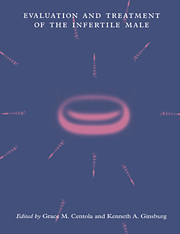Book contents
- Frontmatter
- Contents
- Preface
- List of contributors
- 1 Andrology
- 2 Sperm–egg interaction
- 3 Routine semen analysis
- 4 Computer-aided sperm analysis: a critical review
- 5 Antisperm antibodies: diagnosis and treatment
- 6 The sperm penetration assay
- 7 Intrauterine insemination for male factor
- 8 Processing human semen for insemination: comparison of methods
- 9 New assays for evaluating sperm function
- 10 Assisted reproductive technology for male factor infertility
- 11 Microinjection techniques for male infertility
- 12 Therapeutic donor insemination: screening, indications and technique
- 13 Endocrine assessment and hormone treatment of the infertile male
- 14 The urologic evaluation of the infertile male
- 15 Azoospermia: the diagnosis and treatment
- 16 White blood cells in semen and their impact on fertility
- 17 Psychological aspects of male infertility: lifting the shroud of shame
- 18 Evaluation of the female partner
- Index
Preface
Published online by Cambridge University Press: 16 September 2009
- Frontmatter
- Contents
- Preface
- List of contributors
- 1 Andrology
- 2 Sperm–egg interaction
- 3 Routine semen analysis
- 4 Computer-aided sperm analysis: a critical review
- 5 Antisperm antibodies: diagnosis and treatment
- 6 The sperm penetration assay
- 7 Intrauterine insemination for male factor
- 8 Processing human semen for insemination: comparison of methods
- 9 New assays for evaluating sperm function
- 10 Assisted reproductive technology for male factor infertility
- 11 Microinjection techniques for male infertility
- 12 Therapeutic donor insemination: screening, indications and technique
- 13 Endocrine assessment and hormone treatment of the infertile male
- 14 The urologic evaluation of the infertile male
- 15 Azoospermia: the diagnosis and treatment
- 16 White blood cells in semen and their impact on fertility
- 17 Psychological aspects of male infertility: lifting the shroud of shame
- 18 Evaluation of the female partner
- Index
Summary
Infertility is defined as one year of unprotected intercourse without a conception. Infertility is a couple phenomenon, affecting both partners due either to medical or surgical problems, psychological issues, or both. It occurs in 1 in every 5, or 20% of couples. Of this 20%, 40% of cases are thought to be due primarily to female factors, 40% primarily to male factors, and 20% to both male and female factors.
During the last decade there has also been increased research into the causes and treatments of infertility. Many anatomical, physiological, biochemical, psychological and genetic abnormalities have been identified as associated with human reproduction, and infertility in the female. Yet, factors related to male fertility, such as sperm maturation, sperm capacitation and fertilization, remain a mystery. The study of male fertility – andrology – is currently at the same place that gynecologic infertility was twenty years ago. Many physicians' offices and clinics are not equipped to evaluate and treat the large range of infertility problems. Residents often spend very little time with the fertility specialist, in the fertility clinic or andrology laboratory. The ability to thoroughly evaluate, diagnose and treat male factor infertility are essential parts of the physician's education.
The focus of this book is the evaluation and treatment of the infertile male. It is aimed at the office-based physician who needs a reference on the basic aspects of the investigation, evaluation and diagnosis of the male partner. Current treatment options are provided.
- Type
- Chapter
- Information
- Evaluation and Treatment of the Infertile Male , pp. ix - xPublisher: Cambridge University PressPrint publication year: 1996



